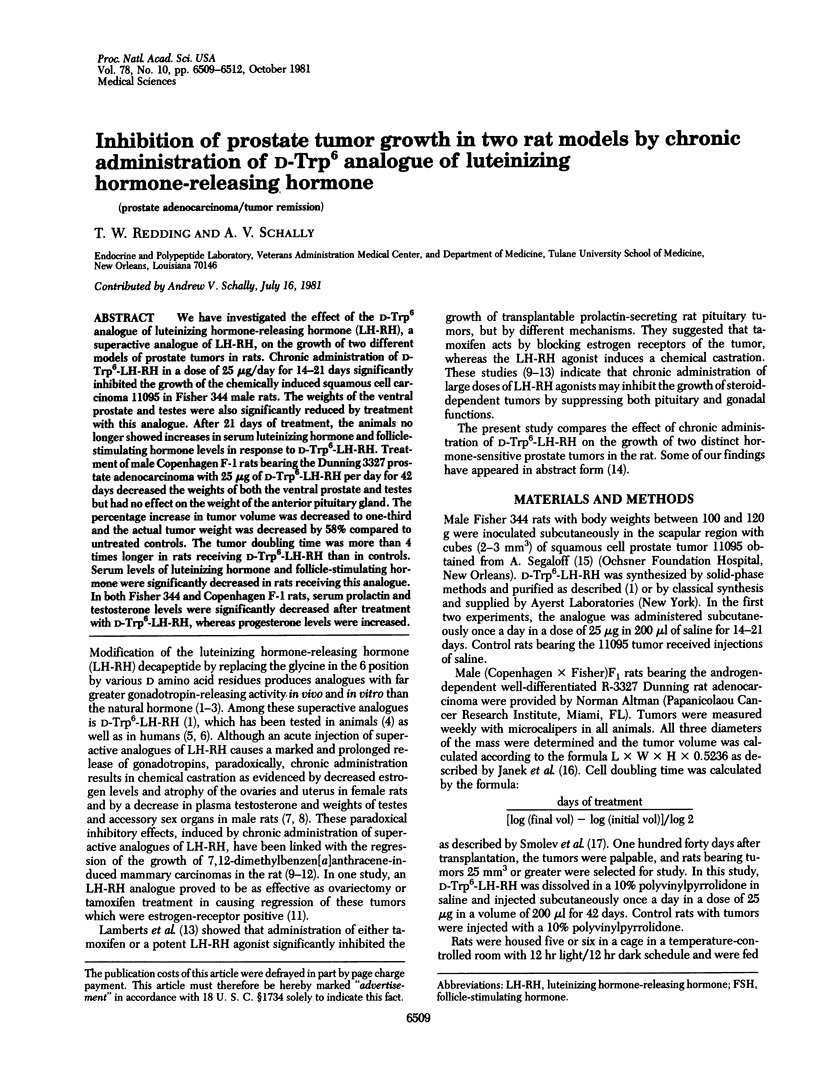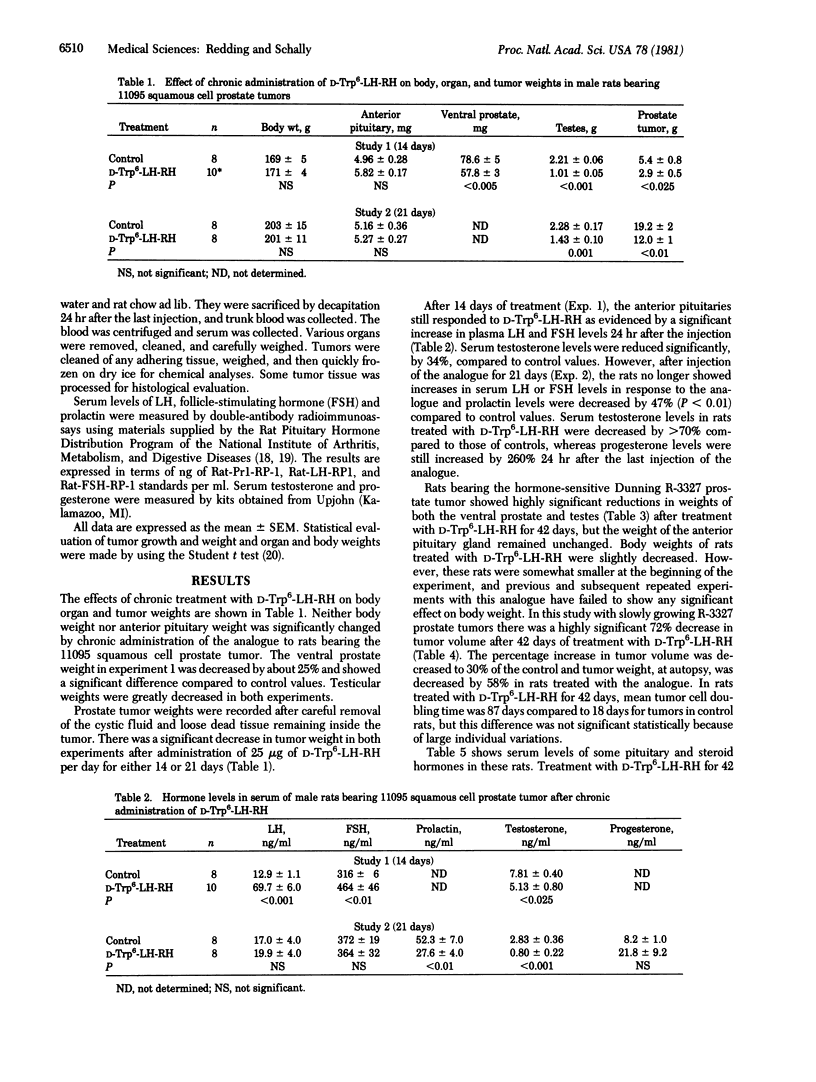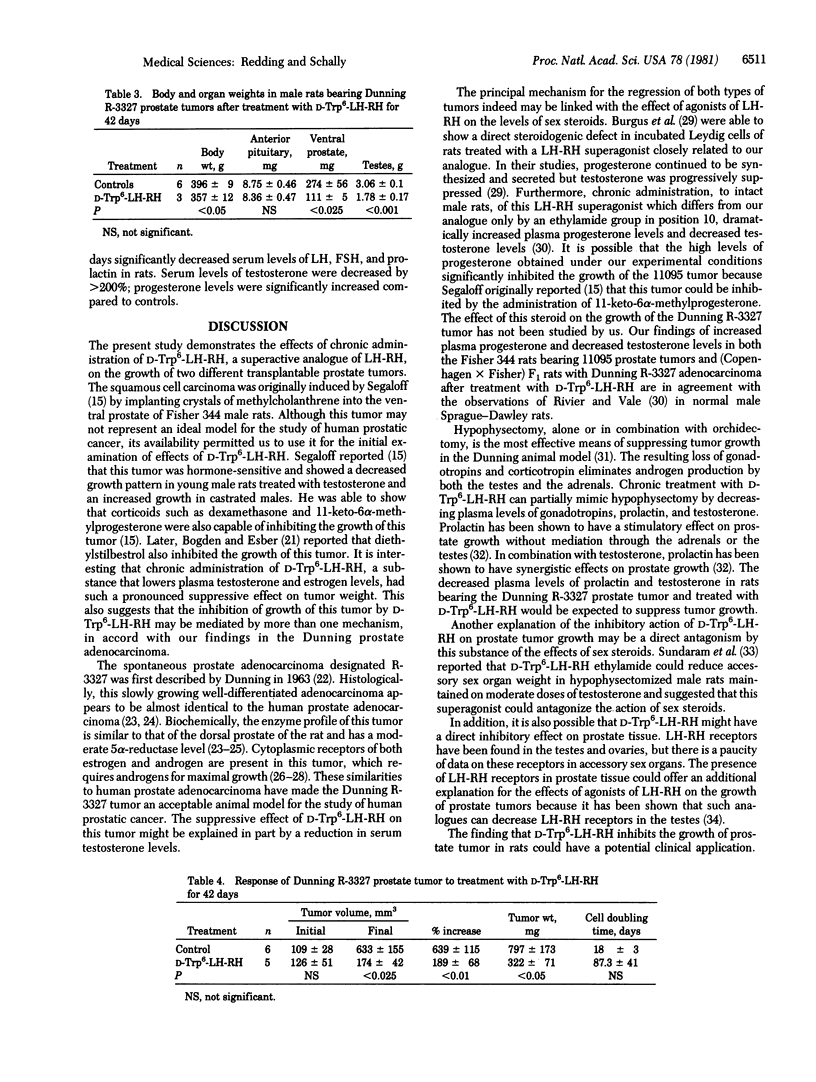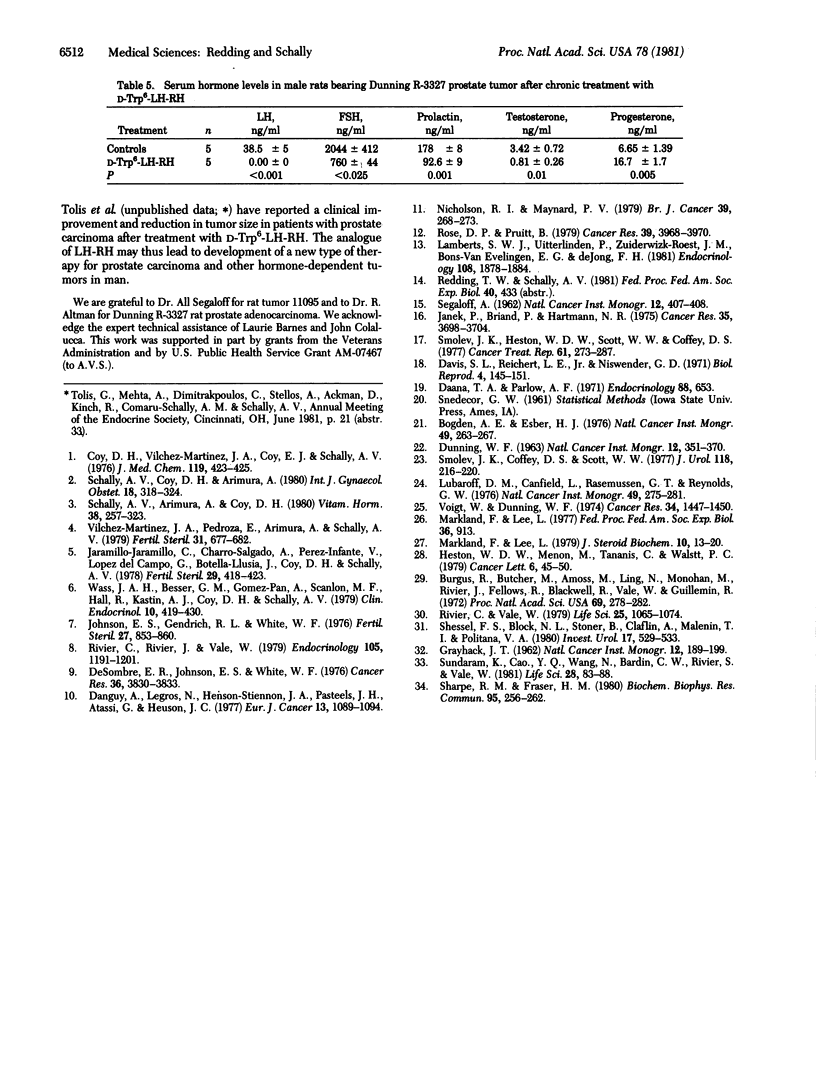Abstract
We have investigated the effect of the D-Trp6 analogue of luteinizing hormone-releasing hormone (LH-RH), a superactive analogue of LH-RH, on the growth of two different models of prostate tumors in rats. Chronic administration of D-Trp6-LH-RH in a dose of 25 micrograms/day for 14-21 days significantly inhibited the growth of the chemically induced squamous cell carcinoma 11095 in Fisher 344 male rats. The weights of the ventral prostate and testes were also significantly reduced by treatment with this analogue. After 21 days of treatment, the animals no longer showed increases in serum luteinizing hormone and follicle-stimulating hormone levels in response to D-Trp6-LH-RH. Treatment of male Copenhagen F-1 rats bearing the Dunning 3327 prostate adenocarcinoma with 25 micrograms of D-Trp6-LH-RH per day for 42 days decreased the weights of both the ventral prostate and testes but had no effect on the weight of the anterior pituitary gland. The percentage increase in tumor volume was decreased to one-third and the actual tumor weight was decreased by 58% compared to untreated controls. The tumor doubling time was more than 4 times longer in rats receiving D-Trp6-LH-RH than in controls. Serum levels of luteinizing hormone and follicle-stimulating hormone were significantly decreased in rats receiving this analogue. In both Fisher 344 and Copenhagen F-1 rats, serum prolactin and testosterone levels were significantly decreased after treatment with D-Trp6-LH-RH, whereas progesterone levels were increased.
Full text
PDF



Selected References
These references are in PubMed. This may not be the complete list of references from this article.
- Burgus R., Butcher M., Amoss M., Ling N., Monahan M., Rivier J., Fellows R., Blackwell R., Vale W., Guillemin R. Primary structure of the ovine hypothalamic luteinizing hormone-releasing factor (LRF) (LH-hypothalamus-LRF-gas chromatography-mass spectrometry-decapeptide-Edman degradation). Proc Natl Acad Sci U S A. 1972 Jan;69(1):278–282. doi: 10.1073/pnas.69.1.278. [DOI] [PMC free article] [PubMed] [Google Scholar]
- Coy D. H., Vilchez-Martinez J. A., Coy E. J., Schally A. V. Analogs of luteinizing hormone-releasing hormone with increased biological activity produced by D-amino acid substitutions in position 6. J Med Chem. 1976 Mar;19(3):423–425. doi: 10.1021/jm00225a018. [DOI] [PubMed] [Google Scholar]
- DUNNING W. F. PROSTATE CANCER IN THE RAT. Natl Cancer Inst Monogr. 1963 Oct;12:351–369. [PubMed] [Google Scholar]
- Daane T. A., Parlow A. F. Periovulatory patterns of rat serum follicle stimulating hormone and luteinizing hormone during the normal estrous cycle as revealed by radioimmunoassays: effects of pentobarbital. Endocrinology. 1971 Mar;88(3):653–663. doi: 10.1210/endo-88-3-653. [DOI] [PubMed] [Google Scholar]
- Danguy A., Legros N., Heuson-Stiennon J. A., Pasteels J. L., Atassi G., Heuson J. C. Effects of a gonadotropin-releasing hormone (GnRH) analogue (A-43818) on 7, 12- dimethylbenz (a)anthracene-induced rat mammary tumors. Histological and endocrine studies. Eur J Cancer. 1977 Oct;13(10):1089–1094. doi: 10.1016/0014-2964(77)90005-6. [DOI] [PubMed] [Google Scholar]
- Davis S. L., Reichert L. E., Jr, Niswender G. D. Serum levels of prolactin in sheep as measured by radioimmunoassay. Biol Reprod. 1971 Apr;4(2):145–153. doi: 10.1093/biolreprod/4.2.145. [DOI] [PubMed] [Google Scholar]
- DeSombre E. R., Johnson E. S., White W. F. Regression of rat mammary tumors effected by a gonadoliberin analog. Cancer Res. 1976 Oct;36(10):3830–3833. [PubMed] [Google Scholar]
- GRAYHACK J. T. PITUITARY FACTORS INFLUENCING GROWTH OF THE PROSTATE. Natl Cancer Inst Monogr. 1963 Oct;12:189–199. [PubMed] [Google Scholar]
- Heston W. D., Menon M., Tananis C., Walsh P. C. Androgen, estrogen and progesterone receptors of the R3327H Copenhagen rat prostatic tumor. Cancer Lett. 1979 Jan;6(1):45–50. doi: 10.1016/s0304-3835(79)80019-1. [DOI] [PubMed] [Google Scholar]
- Janik P., Briand P., Hartmann N. R. The effect of estrone-progesterone treatment on cell proliferation kinetics of hormone-dependent GR mouse mammary tumors. Cancer Res. 1975 Dec;35(12):3698–3704. [PubMed] [Google Scholar]
- Jaramillo C. J., Charro-Salgado A., Peréz-Infante V., del Campo G. L., Botella-Llusiá J., Coy D. H., Schally A. V. Clinical studies with d-Trp 6-luteinizing hormone-releasing hormone in anovulatory women. Fertil Steril. 1978 Apr;29(4):418–423. [PubMed] [Google Scholar]
- Johnson E. S., Gendrich R. L., White W. F. Delay of puberty and inhibition of reproductive processes in the rat by a gonadotropin-releasing hormone agonist analog. Fertil Steril. 1976 Jul;27(7):853–860. doi: 10.1016/s0015-0282(16)41963-1. [DOI] [PubMed] [Google Scholar]
- Lamberts S. W., Uitterlinden P., Zuiderwijk-Roest J. M., Bons-van Evelingen E. G., de Jong F. H. Effects of a luteinizing hormone-releasing hormone analog and tamoxifen on the growth of an estrogen-induced prolactin-secreting rat pituitary tumor and its influence on pituitary gonadotropins. Endocrinology. 1981 May;108(5):1878–1884. doi: 10.1210/endo-108-5-1878. [DOI] [PubMed] [Google Scholar]
- Lubaroff D. M., Canfield L., Rasmussen G. T., Reynolds C. W. An animal model for the study of prostate carcinoma. Natl Cancer Inst Monogr. 1978 Dec;(49):275–281. [PubMed] [Google Scholar]
- Markland F. S., Jr, Lee L. Characterization and comparison of the estrogen and androgen receptors from the R-3327 rat prostatic adenocarcinoma. J Steroid Biochem. 1979 Jan;10(1):13–20. doi: 10.1016/0022-4731(79)90135-3. [DOI] [PubMed] [Google Scholar]
- Nicholson R. I., Maynard P. V. Anti-tumour activity of ICI 118630, a new potent luteinizing hormone-releasing hormone agonist. Br J Cancer. 1979 Mar;39(3):268–273. doi: 10.1038/bjc.1979.50. [DOI] [PMC free article] [PubMed] [Google Scholar]
- Rivier C., Rivier J., Vale W. Chronic effects of [D-Trp6,Pro9-NEt]luteinizing hormone-releasing factor on reproductive processes in the male rat. Endocrinology. 1979 Nov;105(5):1191–1201. doi: 10.1210/endo-105-5-1191. [DOI] [PubMed] [Google Scholar]
- Rivier C., Vale W. Hormonal secretion in male rats chronically treated with [D-Trp6, Pro9-NEt]-LRF. Life Sci. 1979 Sep 17;25(12):1065–1074. doi: 10.1016/0024-3205(79)90592-7. [DOI] [PubMed] [Google Scholar]
- Rose D. P., Pruitt B. Modification of the effect of a gonadoliberin analog on 7,12-dimethylbenz(a)anthracene-induced rat mammary tumors by hormone replacement. Cancer Res. 1979 Oct;39(10):3968–3970. [PubMed] [Google Scholar]
- SEGALOFF A. DISCUSSION ON EXPERIMENTAL TUMORS; OBSERVATIONS ON A SQUAMOUS CELL CARCINOMA. Natl Cancer Inst Monogr. 1963 Oct;12:407–408. [PubMed] [Google Scholar]
- Schally A. V., Arimura A., Coy D. H. Recent approaches to fertility control based on derivative of LH-RH. Vitam Horm. 1980;38:257–323. doi: 10.1016/s0083-6729(08)60487-2. [DOI] [PubMed] [Google Scholar]
- Schally A. V., Coy D. H., Arimura A. LH-RH agonists and antagonists. Int J Gynaecol Obstet. 1980;18(5):318–324. doi: 10.1002/j.1879-3479.1980.tb00507.x. [DOI] [PubMed] [Google Scholar]
- Sharpe R. M., Fraser H. M. Leydig cell receptors for luteinizing hormone releasing hormone and its agonists and their modulation by administration or deprivation of the releasing hormone. Biochem Biophys Res Commun. 1980 Jul 16;95(1):256–262. doi: 10.1016/0006-291x(80)90732-9. [DOI] [PubMed] [Google Scholar]
- Shessel F. S., Block N. L., Stover B., Claflin A., Malinin T. I., Politano V. A. Endocrine manipulation of the Dunning prostatic adenocarcinoma. Invest Urol. 1980 May;17(6):529–533. [PubMed] [Google Scholar]
- Smolev J. K., Coffey D. S., Scott W. W. Experimental models for the study of prostatic adenocarcinoma. J Urol. 1977 Jul;118(1 Pt 2):216–220. doi: 10.1016/s0022-5347(17)57949-5. [DOI] [PubMed] [Google Scholar]
- Smolev J. K., Heston W. D., Scott W. W., Coffey D. S. Characterization of the Dunning R3327H prostatic adenocarcinoma: an appropriate animal model for prostatic cancer. Cancer Treat Rep. 1977 Mar-Apr;61(2):273–287. [PubMed] [Google Scholar]
- Sundaram K., Cao Y. Q., Wang N. G., Bardin C. W., Rivier J., Vale W. Inhibition of the action of sex steroids by gonadotropin-releasing hormone (GnRH) agonists: a new biological effect. Life Sci. 1981 Jan 5;28(1):83–88. doi: 10.1016/0024-3205(81)90369-6. [DOI] [PubMed] [Google Scholar]
- Vilchez-Martinez J. A., Pedroza E., Arimura A., Schally A. V. Paradoxical effects of D-Trp6-luteinizing hormone-releasing hormone on the hypothalamic-pituitary-gonadal axis in immature female rats. Fertil Steril. 1979 Jun;31(6):677–682. doi: 10.1016/s0015-0282(16)44061-6. [DOI] [PubMed] [Google Scholar]
- Voigt W., Dunning W. F. In vivo metabolism of testosterone-3H in R-3327, an androgen-sensitive rat prostatic adenocarcinoma. Cancer Res. 1974 Jun;34(6):1447–1450. [PubMed] [Google Scholar]
- Wass J. A., Besser G. M., Gomez-Pan A., Scanlon M. F., Hall R., Kastin A. J., Coy D. H., Schally A. V. Comparison of long-acting analogues of luteinizing hormone releasing hormone in man. Clin Endocrinol (Oxf) 1979 Apr;10(4):419–430. doi: 10.1111/j.1365-2265.1979.tb02098.x. [DOI] [PubMed] [Google Scholar]


